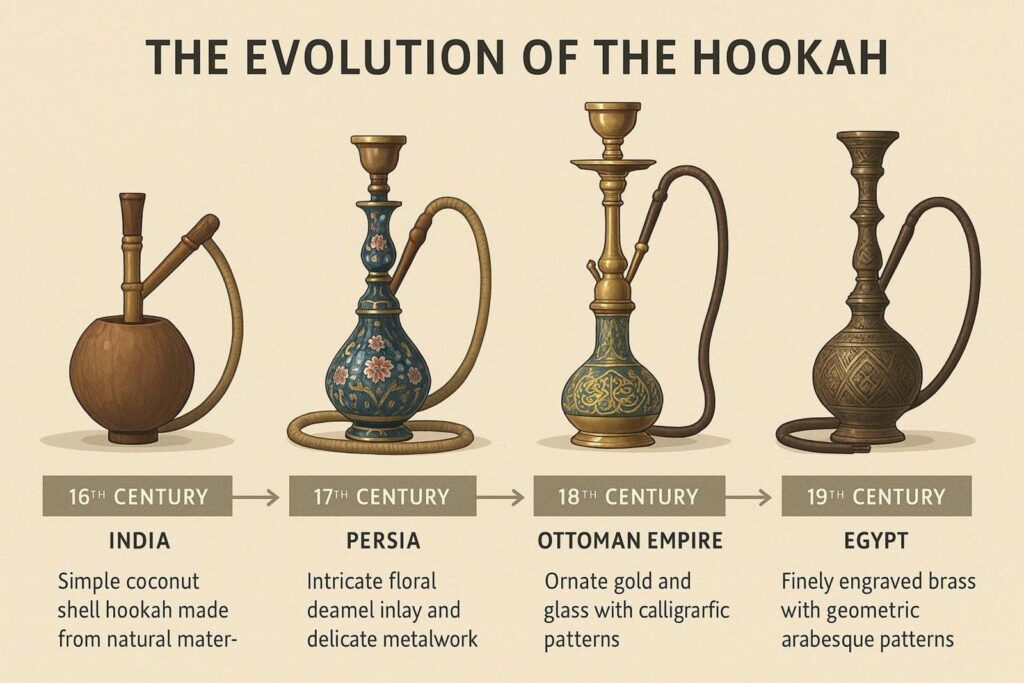Modern hookah designs mix tradition with new ideas. They keep the cultural roots of this old water pipe and add clean looks, new materials, and modern tech. Over time, the hookah moved from coconut shells and carved wood to sleek glass and stainless steel. It has grown from a simple tool into a lifestyle item enjoyed worldwide.
Whether you have years of experience or are just starting, today’s hookahs respect their past while moving forward. To explore recent trends and find a model that matches your style, a hookah online store offers a wide range.
The appeal of modern hookahs is their link to history and their fit with today’s style. They are more than smoking tools; they also show personal taste and smart design.
This article looks at how new designs strike that balance-covering their story, key traits, and updates that lift the hookah experience.
How Hookah Design Evolved: From Tradition to Innovation
The hookah began centuries ago in the Middle East and India. It has changed a lot since then, while still holding on to its role in art, community, and hospitality. As it spread, each place added its own touch, which helped shape the many styles we see now.
Early hookahs were part of social life, not just tools. Makers used what they had-wood, brass, coconut shells-and often added decoration. As hookahs moved across regions, different styles formed, and the hookah became a lasting cultural symbol.
Key Milestones in Hookah Evolution
- Origins in India: early versions made from coconut shells, simple and practical.
- Persia: artisans added decorative work and raised its status.
- Ottoman Empire (16th-17th centuries): grand designs for royal courts and coffeehouses; symbols of refinement and shared time.
- 19th-20th centuries: factories made hookahs more affordable and common in homes and cafes.
- Egypt: workshops kept handcraft traditions alive with hand-engraved brass stems (for example, styles similar to Khalil Mamoon).

Cultural Influences on Shape, Materials, and Artistry
Early Indian and Persian hookahs used coconut shells, carved wood, and brass. These pieces often featured fine engravings and stood for welcome and art in the home.
In the Ottoman Empire, makers focused on luxury. Bases were hand-blown glass with rich colors or gold etching. Brass and silver stems carried floral patterns. Hoses used fabric or leather, giving the hookah the same status as an ornate tea set. Families often displayed them as art.
As trade grew, styles spread and mixed. Egypt made simpler, strong brass-bodied models known for long life and an authentic feel. North African makers used painted ceramic bases with bright patterns. In 18th-19th century Europe, nobles used versions made from glass, porcelain, and silver, showing the hookah could fit many tastes and settings.
What Defines Modern Hookah Design?
Modern hookahs mix heritage with clean, current style. They keep classic parts but add new materials and features for today’s users. The goal is not just looks but a smoother, easier session, thanks to careful engineering and design that fits everyday life.
Interest in modern hookahs has grown. Sales rose from April to August 2025, with a peak in August, then dipped a bit in September. Warmer months saw higher demand, pointing to room for more growth with better features and finishes.
How Traditional Elements Influence Contemporary Styles
Even with new looks, the basic parts stay the same: water base, tall stem, hose, and bowl. This keeps a link to older models and to the social role of the hookah.
Designers often borrow from classic engravings and rich materials, then simplify the look. For example, a stainless steel stem might carry a light etched pattern that echoes brass work from older models. The shared ritual remains, while the setup gets simpler and easier to use. The result feels both familiar and new.
Which Innovations Set Modern Hookahs Apart?
Newer hookahs stand out with updates that improve both look and use:
- Clear glass bases and stems so you can see smoke and water in motion.
- Stronger, rust-resistant metals like stainless steel and aerospace-grade aluminum.
- Clean lines and simple shapes that fit modern rooms.
- Compact, modular builds with magnetic connectors for quick setup and cleaning.
- Tech add-ons: LEDs, adjustable airflow, and even smart apps for presets and session logs.

User feedback points to two main issues: 42.9% say cleaning is hard, and 36.5% report performance hiccups. In response, many brands now offer modular parts, smoother airflow control, and dishwasher-safe pieces to make upkeep easier and sessions more consistent.
Comparing Traditional and Modern Hookah Designs
People often choose between traditional and modern styles. Both cool smoke through water and use similar parts, but they focus on different values. Traditional pieces lean into history, handwork, and a classic feel. Modern options focus on convenience, performance, and a clean look.
The choice is about more than style. It includes build methods, durability, and the ritual of setup and use. Traditional models bring a sense of heritage. Modern ones offer fast setup, steady performance, and lighter builds.
| Aspect | Traditional | Modern |
| Materials | Brass, copper, heavy glass | Stainless steel, aluminum, glass, acrylic, carbon fiber |
| Look | Engraved, ornate, hand-painted | Minimal, geometric, smooth finishes |
| Build | Often handmade; fewer parts | Precision-made; modular parts |
| Setup/Cleaning | Simple assembly; cleaning can be tricky | Quick assembly; easy to take apart and wash |
| Portability | Larger and heavier | Compact options for travel and small spaces |
| Experience | Full pull, nostalgic ritual | Smoother draw, adjustable airflow, quiet diffusers |
Main Characteristics of Traditional Hookahs
Traditional hookahs stand out for their detailed craft and cultural roots. Many come from Egypt, Syria, or Turkey. Stems often use brass, copper, or stainless steel and may carry hand engravings. Bases are thick glass with painted designs. They usually have fewer parts, which makes setup simple, though cleaning tight areas can take time. These hookahs are often larger and heavier, steady on the floor, and known for a smooth, full pull.
Features Found in Modern Hookahs
Modern hookahs aim for steady performance and easy use. Makers often use stainless steel, aluminum, and carbon fiber to keep weight low and fight rust. The look is minimal and clean. Common upgrades include:
- Magnetic or click systems instead of rubber grommets.
- Built-in diffusers for a quiet and smooth draw.
- Modular parts for quick cleaning and better portability.
- Clear bases, sometimes with LEDs for a lively visual.
- Adjustable airflow for fine control.
What Has Stayed the Same-and What Has Changed?
The base, stem, hose, and bowl remain the core of every hookah. The social side-sharing and relaxing together-still defines the experience.
What changed most is how a hookah shows personal style. An Ottoman piece once signaled status and art. A glass-and-steel model now signals modern taste and a tech-friendly setup. Many traditional models are still crafted by hand, so each has small differences. Modern ones are made with tight tolerances and often come with extra parts and upgrades.
Innovative Features That Improve the Hookah Experience
Recent updates to hookah design solve old pain points: slow setup, hard cleaning, and limited control. New builds aim to look good and work well, giving smoother, cleaner, and more personal sessions.
From metals and glass to smart add-ons, each change supports easier care and better performance. The result is a hookah that looks sharp and is simple to use day after day.
Advanced Materials: Glass, Stainless Steel, Acrylic, and More
Material choice shapes flavor, upkeep, and look:
- Glass: clean taste that does not hold past flavors, easy to see through, simple to wash.
- Stainless steel/aluminum: strong, light, and rust-resistant; polished or matte finishes.
- Acrylic: tough and light, less likely to break than glass; often pairs with LED lighting.
- Wood: classic warmth with a natural feel; some users say it adds a mild earthy note.
This mix of options lets buyers pick by taste, upkeep needs, and style.
Technology Integration: LED Lighting, Magnetic Seals, Adjustable Valves
Tech now plays a clear role in modern hookahs. LED bases add color and mood with a remote or app. Magnetic and click-lock joints replace rubber seals, making airtight connections and fast setup. Adjustable valves and tuned airflow let users pick the draw they like.
Some models, such as the REVA electronic hookah, go further with app control, flavor presets, session logs, and use without charcoal.
Functional Upgrades: Multi-hose Options, Detachable Parts, Easy Cleaning
Multi-hose setups let friends smoke at the same time, often with valves so each person has steady airflow. Many newer hookahs use modular parts and silicone gaskets so you can take everything apart and wash it fast.
With 42.9% of users calling cleaning a problem, makers now offer dishwasher-safe parts and smoother inner surfaces. These updates cut setup time and make after-session care quick and simple.
Popular Modern Hookah Styles That Balance Old and New
Today’s market offers many styles that respect tradition while fitting modern spaces and routines. There is something for minimal interiors, art lovers, frequent travelers, and fans of custom builds.
Some models blend in with living rooms like decor pieces. Others focus on mix-and-match parts for personal taste. Below are styles that show this balance.
Minimalist and Artistic Designs
Minimal designs use straight lines, simple shapes, and calm colors. Brands like Amotion favor clean European looks that fit modern rooms. Glass hookahs lead this trend: their clear bodies show smoke movement and deliver pure flavor. Some designs play with unique materials or sculpted forms, trading heavy engravings for quiet elegance.
Customizable and Modular Hookah Systems
Custom builds move away from one standard setup. OEM options let users pick materials, colors, sizes, number of hoses, bowl types, and airflow features. Many brands use 3D modeling to plan parts and fit.
Modular pieces make assembly, cleaning, upgrades, and replacements easy. This level of choice helps each user create a hookah that fits their habits and style.
Tabletop and Portable Hookahs for On-the-Go
For small spaces or active lives, tabletop and portable models keep things compact without giving up quality. Many are light, collapsible, and quick to pack for travel or outdoor use.
Mini hookahs suit quick solo sessions and tight spaces. The Hookah Tree Beaker 2.0 Hookah shows how easy setup, cleaning, and storage can be. Travel models often ship with cases and tougher materials. The Vyro One is popular for fast assembly and strong build. These compact designs let users enjoy a full session almost anywhere.
What Should You Consider When Choosing a Modern Hookah?
Picking a modern hookah can feel like a big task because there are many choices in look, material, and features. Think about how you plan to use it, how often, where you will store it, and how much time you want to spend on cleaning and care. A good choice brings long-lasting enjoyment.
The goal is to match looks with strong performance and easy day-to-day use. The points below can help you pick a hookah that fits you well.
Aesthetics versus Performance: What Matters Most?
Some buyers want a showpiece that lifts a room-minimal lines, clear glass, or bold shapes. Others focus on performance: smooth pull, steady smoke, and rich flavor. For performance-first buyers, look for steady airflow, diffusers, and high-grade metals or heat-safe glass.
Many modern models try to offer both, but you should decide which side matters more to you.
Material Durability and Maintenance Needs
Material choice affects strength and care. Stainless steel and aerospace-grade aluminum are strong, light, and fight rust. Glass gives pure flavor and a clean look, but it needs careful handling.
Many users want strong builds and dishwasher-safe parts to make cleaning quick. Detachable sections and silicone gaskets help a lot. If you plan to smoke often, pick materials and designs that match your routine so upkeep stays simple.
Challenges in Balancing Authenticity and Innovation
Mixing old and new is not always easy. Designers must keep cultural roots while adding modern shapes, materials, and tech. The hookah carries long-standing meaning in South Asia and the Middle East, so updates need to respect that history.
The aim is to add new features while keeping the ritual, the social side, and the story behind the hookah alive. The points below show where this balance can be hard.
Preserving Cultural Identity in Modern Designs
The hookah is tied to art and hospitality. As models get sleeker, there is a risk that classic details fade. Designers can keep links to the past with familiar shapes, motifs, or materials, even in a cleaner form. They can keep the key parts that connect new models to older ones. Doing this helps the hookah stay a bridge between generations.
Addressing Health and Quality Concerns with New Materials
New materials bring benefits but also questions. Stainless steel, aluminum, and plastics like acrylic are light and corrosion-resistant, but they must be safe under heat and regular use. Brands need steady testing and quality checks so parts do not add unwanted chemicals or affect taste.
Feedback about uneven performance or material worries shows why strong standards matter. Electronic hookahs like REVA also need safe heating and clean air paths to support good health and safety without charcoal.
Looking Ahead: Future Trends in Hookah Design
Hookah design keeps changing as tastes and needs shift worldwide. New trends point to more eco-minded choices, better tech, and more personal options.
The hookah is set to keep growing with new ideas while holding onto its roots. Expect models that are smart, personal, and mindful about materials and impact.
Sustainability and Eco-Friendly Materials
Expect more use of eco-minded materials like bamboo, recycled glass, and greener metals. Makers will look for ways to use these without losing strength, performance, or style. Packaging and factory steps may also move to cleaner methods. This approach suits buyers who want products that match their values.
Emerging Technologies and Customization Trends
Smart features will go beyond simple LEDs. Think sensors that track smoke density and temperature, with tips sent to an app. Magnetic joints and finely tuned airflow will get even better.
Custom options will expand, with deeper OEM programs and 3D-modeled parts. Users will mix materials and swap modules for both looks and function. In time, many hookahs may feel like personal art pieces that also work exactly how the owner wants.



